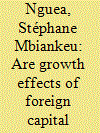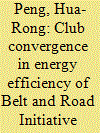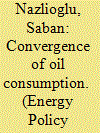|
|
|
Sort Order |
|
|
|
Items / Page
|
|
|
|
|
|
|
| Srl | Item |
| 1 |
ID:
186453


|
|
|
|
|
| Summary/Abstract |
There is increasing scientific evidence of anthropic climate change. The need to shift to more sustainable energy systems is therefore compelling. Individuals are becoming key actors in the energy transition, as producers and sellers of the renewable energy they produce on-site. However, the practice of self-consumption requires to be underpinned by adequate policy mechanisms. Under this perspective, the Spanish Royal Decree (RD) 900/2015, also so-called “Tax on the Sun”, aiming at regulating energy self-consumption and enhancing the engagement of Spanish citizens in the energy transition as prosumers, by the installation of photovoltaics, represents a challenging case study. There is anecdotal evidence that instead of supporting the diffusion of electricity self-consumption, the “Tax on the Sun” has had the opposite effect. Thus, this work aims at testing this proposition by using the synthetic control methodology (SCM), which permits to evaluate the effect of a treatment in absence of a suitable control group, as in this case. This study finds that indeed at the regional level the “Tax on the Sun” has had a negative impact, if any at all. The current barriers to prosumerism, and more broadly to the active involvement of citizens in the energy transition, are still many and policy-makers should address these shortcomings if they want to fully employ the potential that prosumerism has to offer to a just energy transition.
|
|
|
|
|
|
|
|
|
|
|
|
|
|
|
|
| 2 |
ID:
186491


|
|
|
|
|
| Summary/Abstract |
Sub-Saharan Africa's electrification rate of 45% in 2018 remains extremely low compared with other developing regions. This study investigates if foreign capital could significantly contribute to enhancing the electricity access rate in Africa, a subject so far neglected in the literature. Specifically, it seeks to know whether increasing FDI, remittances and foreign aid matter for access to electricity in Africa. We utilize a dynamic panel System-Generalized Method of Moments (Sys-GMM) estimator to analyse data collected on a panel of 36 African countries over 2000–2017. The empirical findings show that FDI and remittances are positively and significantly related to increasing access to electricity. Moreover, our results show that foreign aid reduces the electricity access. We finally find that remittances reduce urban-rural disparities in access to electricity, while FDI and foreign aid increase disparities. These results remain consistent when we perform sub-regional analyses, suggesting that African countries should rely more on remittances and FDI to promote universal access to electricity.
|
|
|
|
|
|
|
|
|
|
|
|
|
|
|
|
| 3 |
ID:
186469


|
|
|
|
|
| Summary/Abstract |
Marine energy (i.e., energy from waves, tides, currents) in the United States is a nascent industry. In particular, permitting processes—an uncertainty for industry advancement that can be costly and time consuming to navigate—have rarely been tested and used for marine energy. The novelty of the marine energy industry and utilization of open ocean permitting processes that were not originally developed for marine energy have led to extensive efforts to gain consensus amongst state and federal regulatory agencies to authorize marine energy projects. In 2021, Oregon State University successfully completed permitting of a wave energy test facility, called PacWave South, off the coast of Oregon, which is designed to advance wave energy research and development. This article documents the multi-year process that Oregon State University used to receive federal and state authorization for a pre-permitted commercial-scale grid-connected facility by detailing the development of the test facility, management of uncertainty and challenges, and key decisions. The PacWave South case study provides insights for the larger marine energy community as the industry advances towards commercialization.
|
|
|
|
|
|
|
|
|
|
|
|
|
|
|
|
| 4 |
ID:
186450


|
|
|
|
|
| Summary/Abstract |
The 2010 energy subsidy reform in Iran is a unique case of redistributive policy as the savings from the subsidy cut have been redirected to households as unconditional, universal cash transfer. While theoretically, the cash transfer was large enough to keep the utility of the average household at the initial level, this study explores the practical impacts of the reform. We analyze panel data on income/expenditure of Iranian households for the period 2010–2012. Since this is a universal reform, we exploit the time dimension and the intensity of energy consumption in the identification and assess the robustness of the results with sub-sample and placebo analyses. Overall, the energy subsidy reform caused a significant shrinkage (7%–9%) in households' real consumption. The cash transfer failed to fully compensate the negative impact of the subsidy removal. The impact is heterogeneous, varying along the intensity of energy consumption, geographical location, income and the share of the cash transfer in a household's income. A non-negligible policy accomplishment of the reform is that within its first two years poverty was mitigated in absolute and relative terms and income inequality slightly improved. Nevertheless, the government is under pressure because inflation counteracts these gains.
|
|
|
|
|
|
|
|
|
|
|
|
|
|
|
|
| 5 |
ID:
186483


|
|
|
|
|
| Summary/Abstract |
The Tokyo emissions trading scheme (ETS) is the first regional ETS in Japan, where a national ETS has not been introduced. In this study, we estimate the policy impacts of the Tokyo ETS on energy usage and economic activities during the scheme’s first phase (2010–2014) and the first four years of its second phase (2015–2018) using business establishment-level panel data from 2007 to 2018. From the matching-based difference-in-differences (DID) estimation results, we find that while regulated business establishments reduced their energy usage beyond their reduction targets set by ETS regulation, the unregulated business establishments chosen by the matching strategy as a comparison group also decreased their energy usage to the same extent. Additionally, the Tokyo ETS did not have a negative impact on the economic activities of regulated business establishments during phases I and II. These results suggest that the emissions cap levels in each phase may not have been sufficiently demanding to induce regulated business establishments to implement additional energy use reduction practices.
|
|
|
|
|
|
|
|
|
|
|
|
|
|
|
|
| 6 |
ID:
186466


|
|
|
|
|
| Summary/Abstract |
This study takes the CO2 emissions from the energy consumption of 30 provinces in China as the research object. We predict and analyze a significant phenomenon involving the total CO2 emissions of inter-provincial energy consumption from the east to the west. On the basis of three CO2 emission reduction scenarios (Scenario 1: Baseline Scenario (10%–20% emission reduction target), Scenario 2: 2 °C Path Scenario (50%–60% emission reduction target), and Scenario 3: 1.5 °C Path Scenario (75%–85% emission reduction target)), a regional synergy scenario is proposed for the first time in this article. That is, the government develops multi-field CO2 regional synergistic emission reduction (RSER) based on regional industry coordination by rationally guiding the implementation of the “enclave economy.” Moreover, we compare and analyze the different carbon emissions of the multiple “Carbon Neutrality” targets in 2050 under multiple scenarios. The results reveal that compared with scenario 1, scenario 2, and scenario 3, the regional synergy scenario can achieve 18.4%, 58.4%, and 83.4% reduction, respectively, compared with the current situation, which is significantly higher than the effect of the emission reduction targets set based on the average threshold values (15%, 55%, and 80%) of the above scenarios.
|
|
|
|
|
|
|
|
|
|
|
|
|
|
|
|
| 7 |
ID:
186434


|
|
|
|
|
| Summary/Abstract |
Many U.S. cities are implementing policies to reduce greenhouse gas (GHG) emissions of their buildings. These range from building energy benchmarking and disclosure to building performance standards (BPS) that require buildings to meet specific targets of energy use or emissions. The City of Seattle adopted a climate action plan in 2013 that set a goal of zero net GHG emissions in the road transportation, buildings, and waste sectors by 2050 (Seattle Office of Sustainability and Environment, 2013), with a number of near and long term actions. Seattle implemented mandatory building tune-ups in 2016, applying to commercial buildings larger than 50,000 sqft (“Seattle Building Tune-Ups,” n.d.). Building tune-ups1 involve assessment and implementation of operational and maintenance (O + M) improvements to achieve energy and water efficiency, such as changes to thermostat set points or adjusting lighting or irrigation schedules (Sullivan et al., 2020).
|
|
|
|
|
|
|
|
|
|
|
|
|
|
|
|
| 8 |
ID:
186443


|
|
|
|
|
| Summary/Abstract |
Carbon prices and carbon caps need to be set at levels that will deliver the reduction targets necessary to keep global warming under 2 °C, aspiring to 1.5 °C above pre-industrial levels, in line with the Paris Agreement. Given both the urgency of the situation and the heterogeneity across countries and sectors, switching caps and switching prices may be the answer.
|
|
|
|
|
|
|
|
|
|
|
|
|
|
|
|
| 9 |
ID:
186490


|
|
|
|
|
| Summary/Abstract |
Countries along with the Belt and Road Initiative (BRI) differ in geographical location, technological levels, and resource endowment. It is worth paying attention to the evolution of the gap in energy efficiency of BRI countries. Therefore, this study investigated club convergence in total-factor energy efficiency (TFEE) of BRI countries, and the role of China's outward foreign direct investment (OFDI) in TFEE convergence, by adopting panel data over 1996–2019. Results indicate that the TFEE of the BRI countries showed a trend of divergence as a whole, but converged to three convergence clubs with different characteristics of 1) high TFEE and convergence rates (20 countries); 2) middle TFEE and convergence rates (13 countries), 3) low TFEE and convergence rates (27 countries). We also found that China's OFDI in low-carbon industries in BRI countries contributed to the convergence of clubs with high energy efficiency and convergence rates. Moreover, China's OFDI in high-carbon industries showed a pollution halo effect, causing lower energy efficiency countries to converge to the high energy efficiency and convergence rate club.
|
|
|
|
|
|
|
|
|
|
|
|
|
|
|
|
| 10 |
ID:
186456


|
|
|
|
|
| Summary/Abstract |
Selecting a suitable energy demand forecasting method is challenging due to the complex interplay of long-term trends, short-term seasonalities, and uncertainties. This paper compares four time-series models performance to predict total and peak monthly energy demand in India. Indian's Central Energy Authority's (CEA) existing trend-based model is used as a baseline against (i) Seasonal Auto-Regressive Integrated Moving Average (SARIMA), (ii) Long Short Term Memory Recurrent Neural Network (LSTM RNN) and (iii) Facebook (Fb) Prophet models. Using 108 months of training data to predict 24 months of unseen data, the CEA model performs well in predicting monthly total energy demand with low root-mean square error (RMSE 4.23 GWh) and mean absolute percentage error (MAPE, 3.4%), but significantly under predicts monthly peak energy demand (RMSE 13.31 GW, MAPE 7.2%). In contrast, Fb Prophet performs well for monthly total (RMSE 4.23 GWh, MAPE 3.3%) and peak demand (RMSE 6.51 GW, MAPE 3.01%). SARIMA and LSTM RNN have higher prediction errors than CEA and Fb Prophet. Thus, Fb Prophet is selected to develop future energy forecasts from 2019 to 2024, suggesting that India's annual total and peak energy demand will likely increase at an annual growth rate of 3.9% and 4.5%, respectively.
|
|
|
|
|
|
|
|
|
|
|
|
|
|
|
|
| 11 |
ID:
186435


|
|
|
|
|
| Summary/Abstract |
Despite of the promising benefits of modern and clean cooking energies, its adoption has been extraordinarily low in Tanzania principally owing to preferences for Dirty and Clean Energy Mixes (DCEMs) over Clean Energy Mixes (CEMs). This study examines this energy stacking behavior based on a 2018 survey dataset of 245 useable responses from Kigamboni district in Dar es Salaam Tanzania. It is notable that the energy transition is from Single Dirty Energy (SDE) or Dirty Energy Mixes (DEMs) towards CEMs via Single Clean Energy (SCE) i.e. LPG with DCEMs in both its lower and upper sides. This approach tends to lengthen the path of transition because CEMs for cooking purposes is only affordable to the minority very high SES class. As a result the majority poor are pushed into the dirty energy “trap” despite of the booming LPG market. Although LPG support initiatives can eliminate dirty non-commercial energies, such initiatives cannot solely be relied upon to reducing the domestic consumption of dirty commercial energies even at high SES. Policy options are two way; either to alleviate SES to the level that quicken the transition or adopt wider electrification alongside appliance subsidies or microfinance to enhance CEMs affordability.
|
|
|
|
|
|
|
|
|
|
|
|
|
|
|
|
| 12 |
ID:
186433


|
|
|
|
|
| Summary/Abstract |
Growing concerns about long-run equilibrium in the oil market have focused on understanding the time path of oil consumption across countries. This study examines the convergence of oil consumption across the largest oil consumers. To this end, we employ the historical oil consumption data dating back to 1890 by benefiting from the newly proposed convergence concepts, including relative/club convergence and weak -convergence, in addition to the conventional β-convergence notion. The empirical results provide new and insightful findings. First, considering common factors in the dynamics of oil consumption leads to convergence. Second, the overall evidence of absolute convergence has been at work among countries mainly before the great depression 1890–1929, while divergence occurs after the mid of 1990s. Third, the divergence observed over the last decades persists even after accounting for either a relative or weak form of convergence, supporting the primary role of the current dynamics in world oil markets. Divergence calls for stricter energy transition policies. Moreover, the clustering algorithm identifies unique convergent clubs, indicating that a unified energy policy is not tenable.
|
|
|
|
|
|
|
|
|
|
|
|
|
|
|
|
| 13 |
ID:
186436


|
|
|
|
|
| Summary/Abstract |
The Saudi agricultural sector relies on diesel for irrigation that is provided to farmers at a price much lower than the average global price, implying significant opportunity costs. By soft-coupling power and macroeconometric models, we assessed cost and economic (macro and sectoral) implications of electrifying irrigation activities in the Saudi agricultural sector via three scenarios: electrifying each individual farm with a dedicated hybrid renewable micro-grid, electrifying the entire farm cluster with central generation, and connecting the entire cluster to the national grid. Compared with the base-case, connecting the farm cluster to the national grid was the most economic but least environmentally friendly. The renewable and central generation scenarios were costlier due to high battery costs and gas infrastructure needed, respectively. Further, the financial viability of the renewable microgrid option depends on the opportunity cost assumption. From an economic (macro and sectoral) perspective, we found that: (i) job and value-added creation effects of saved-diesel spending from export revenues is positive, but quite small implying the more diesel displaced the more benefits realized, (ii) sectoral-specific spending is more growth- and employment-enhancing than general-spending of the government suggesting taking measures to further enhance the efficiency of governmental spending as highlighted in the Fiscal Sustainability Program
|
|
|
|
|
|
|
|
|
|
|
|
|
|
|
|
| 14 |
ID:
186444


|
|
|
|
|
| Summary/Abstract |
This paper surveys climate and energy policy in the EU transport sector covering the road, aviation, and shipping sectors. We summarise current policies, focusing on the Fit for 55 Package, and link the different instruments being used (e.g. cap-and-trade, tax, mandate, performance standard, or subsidy) to different sources of market failure. Next, we analyse the static and dynamic cost-efficiency of the policies and instruments. We find that they address a range of market inefficiencies, but that there are still a number of aspects that can further improve the cost-effectiveness of current EU climate policies in the transport sector. For example, higher taxes and emission performance standards for aviation and shipping, the right combination of research and innovation investments and learning-by-doing policies, and balancing implicit carbon prices by revising the road tax system and adding congestion tolls and charges. Finally, European policy has important side effects on the rest of the world that need to be taken into account in the selection of policies. This improved set of policies can support a sustainable recovery and reach the European Union's climate targets at the lowest cost.
|
|
|
|
|
|
|
|
|
|
|
|
|
|
|
|
| 15 |
ID:
186467


|
|
|
|
|
| Summary/Abstract |
Collusive contracting with private power plants in Bangladesh has resulted in high power prices that cost the taxpayer around U$1 billion in subsidies. The main driver of collusive contracting is the unwillingness of politically unconnected firms to engage in a high-risk environment. To attract investment, the government has adopted a targeted risk absorption strategy that negotiates mark-ups with interested firms. We argue that this strategy cannot discover the minimum mark-up that would induce investment. Moreover, because only politically connected investors are likely to be bidding and negotiating, this approach encourages investors to set high mark-ups. An alternative strategy is competitive risk-mitigation that provides contestable subsidies from development finance institutions (DFIs), such as preferential finance and partial risk guarantees. Contestable subsidies work by reducing risks of unconnected investors, encouraging their participation to make collusion more difficult, and constraining mark-ups. To test our hypothesis, we collect a dataset on plant-level DFI support and prices from 58 private power plants in Bangladesh from 2004 to 2017. Our empirical analysis finds that financing instruments with contestable subsidies from DFIs are associated with a 26% reduction in plant-level prices controlling for plant capacity, size, and fuel type.
|
|
|
|
|
|
|
|
|
|
|
|
|
|
|
|
| 16 |
ID:
186498


|
|
|
|
|
| Summary/Abstract |
The role of publicly funded organisations in implementing accelerated low carbon innovation policy is receiving increasing attention. Due to different national contexts and priorities however, policy makers face high levels of complexity in understanding what organisational approaches might best suit their aims. This paper develops a set of ten principles for accelerated innovation organisation design, which seek to provide policy makers with a tool to better understand the interplay of different design features on innovation outputs. The principles are applied to a comparative case study of the Energy Technologies Institute (ETI), United Kingdom (UK), and the Advanced Research Projects Agency– Energy (ARPA-E), United States (US). Results demonstrate that the design of the ETI, which embedded incumbent industry actors and engaged a narrower set of staff competencies, caused it to prioritise un transformative innovation, contrary to its initial mission. Conversely, the operational approach of ARPA-E has created an entrepreneurial, flexible approach to pursuing transformative innovation. The organisation however lacks long term stability in a changing political environment. Conclusions explore the implications of these results for policy makers seeking to design organisations that are effective in accelerating low carbon innovation.
|
|
|
|
|
|
|
|
|
|
|
|
|
|
|
|
| 17 |
ID:
186463


|
|
|
|
|
| Summary/Abstract |
Future retail electricity markets require development to accelerate the net-zero carbon transition. Adopting a customer-centric approach to market design is necessary to fully utilise smart grid technologies. In this perspective we postulate that empowering energy consumers to become an integral component of the smart grid will lead to heightened renewable energy deployment and network flexibility.
|
|
|
|
|
|
|
|
|
|
|
|
|
|
|
|
| 18 |
ID:
186474


|
|
|
|
|
| Summary/Abstract |
Against the backdrop of the COVID-19 pandemic, the study explores the hedging and safe-haven potential of green bonds for conventional equity, fixed income, commodity, and forex investments. We employ the cross-quantilogram approach to understand better the dynamic relationship between two assets under different market conditions. Our full sample results reveal that the green bond index could serve as a diversifier asset for medium- and long-term equity investors. Besides, it can serve as a hedging and safe-haven instrument for currency and commodity investments. Moreover, the sub-sample analysis of the pandemic period shows a heightened short- and medium-term lead-lag association between the green bond index and conventional investment returns. However, the green bond index emerges as a significant hedging and safe-haven asset for long-term investors of conventional financial assets. Our findings offer valuable insights for long-term investors when their portfolios are comprised of conventional assets such as equities, commodities, forex, and fixed income securities. Further, our findings reveal the potential role of green bond investments in global financial recovery efforts without compromising the low-carbon transition targets.
|
|
|
|
|
|
|
|
|
|
|
|
|
|
|
|
| 19 |
ID:
186460


|
|
|
|
|
| Summary/Abstract |
Over the last decade, residential energy consumption has become a major contributor to global energy use and carbon emissions, and its contributions, especially in developing regions, are accelerating more rapidly than those of the industrial sector. The energy efficiency of the building stock has shown great potential for reducing household energy consumption through advanced measures on the envelopes of buildings, such as the use of advanced construction materials and improvements in building structures. Thus, policies have been implemented to improve energy efficiency and reduce carbon emissions from buildings. This paper analyses survey data from Guangzhou, a megacity with a subtropical climate in South China, to estimate the effects of energy efficiency on the energy consumption of residential buildings. We apply an econometric approach to examine the effects of energy efficiency, and we employ instrumental variables to address problems of endogeneity. The results show that greener buildings, in terms of advanced building materials and structures oriented towards high energy efficiency, reduce the carbon footprints of households. Additionally, households with low income levels and those with environmentally friendly energy consumption behaviour are likely to benefit from living in energy efficient buildings more than other households. Finally, suggestions on ways to improve energy policy and methods to reduce household energy consumption and carbon (CO2) emissions are presented.
|
|
|
|
|
|
|
|
|
|
|
|
|
|
|
|
| 20 |
ID:
186480


|
|
|
|
|
| Summary/Abstract |
Despite extensive attention paid to emissions trading policy (ETP) approaches, the effect of ETP on economic performance is still ambiguous, and its mechanism and policy scenarios remains to be clarified. This study uses panel data at county level from 2002 to 2017 in Zhejiang province to explore the effects of China's ETP on the economic development. Adopting the difference-in-differences (DID) model, it reveals that 1) China's ETP has an aggregative negative impact on county economy. 2) gradual regression results shows that investment intensity inhibitory effect is proved and investment intensity has a strong mediating role, but innovation-boosting effect (Porter hypothesis) is not well supported as ETP does not spur the level of innovation and total factor productivity. 3) Further study shows the level of industrialisation, business environment and financial development in the county can significantly moderate the negative impact of ETP on regional economic development. This study extends the literature of environmental policy and economic development, by providing the empirical evidence at county level with 16-year time span, to generate the solid basis of ETP implementation. Overall, this study has important implications for the government to further evaluate policy effectiveness and promote ETP gradually.
|
|
|
|
|
|
|
|
|
|
|
|
|
|
|
|
|
|
|
|
|